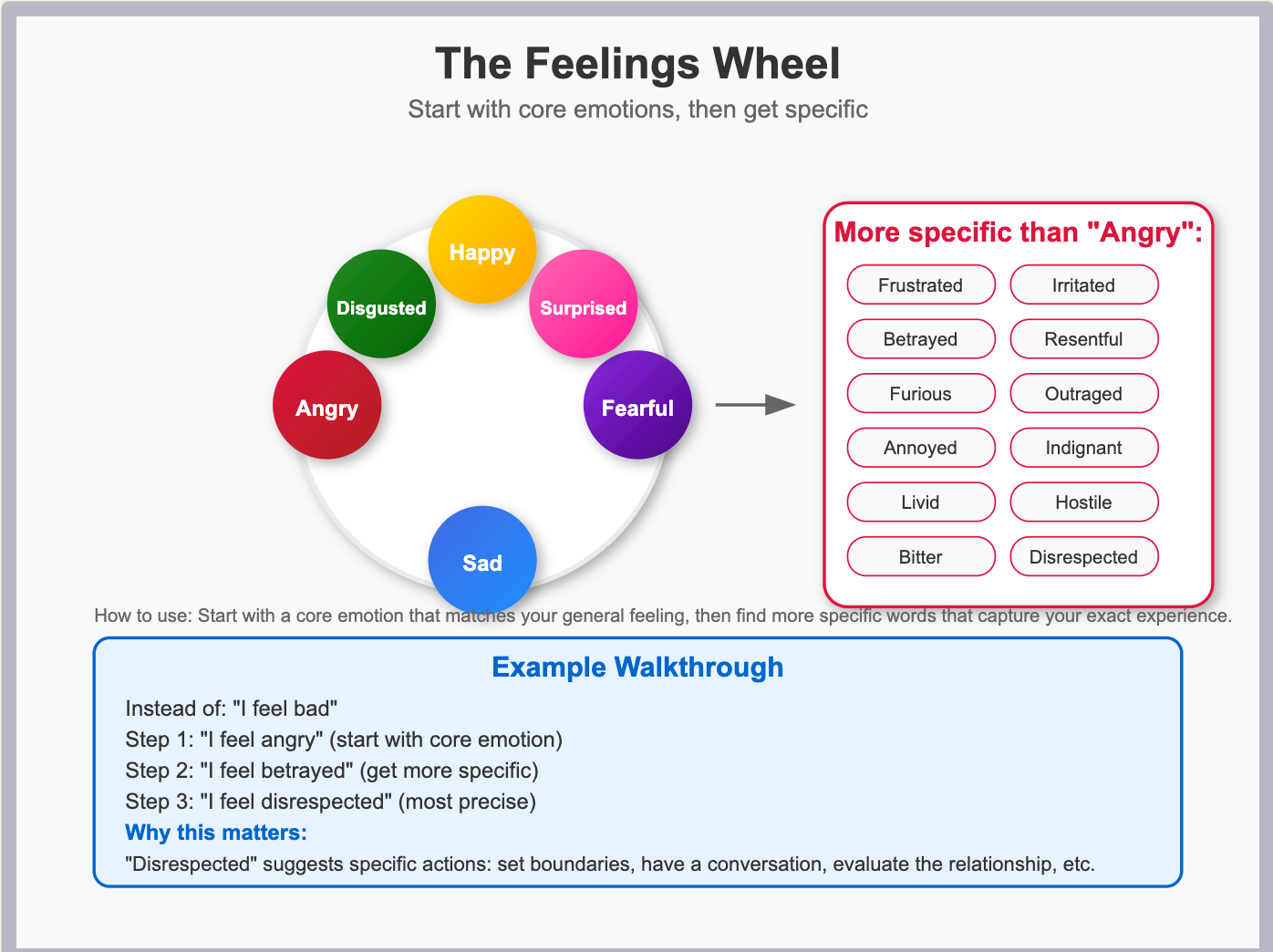The Feelings Wheel: Beyond "Good," "Bad," and "Fine"
Expanding your emotional vocabulary from kindergarten to graduate level.

When someone asks how you're feeling, what do you usually say?
If you're like a lot of people, your answer probably falls somewhere in the range of good, bad, fine, okay, or maybe stressed.
These five words cover maybe 5% of actual human emotional experience, but for some of us—including me—they become default responses.
I learned this the hard way during my early therapy sessions. As I mentioned in a previous post about the felt sense, my therapist kept asking me to describe how I felt at different times.
I'd answer, and she'd say, "Okay, but that's not a feeling."
I was always thinking with my head instead of feeling with my body. And even when I finally understood the difference, my vocabulary was embarrassingly limited. "Oh, that felt good" or "It was bad." Pretty basic!
At one point my therapist started to get frustrated. "Aren't you a writer?" she asked. "Surely you can come up with more descriptive terms."
She was right—but it was difficult. Many of us operate with a kindergarten emotional vocabulary well into adulthood.
Why This Matters (Especially for Neurodivergent People)
This limited emotional vocabulary isn't just inconvenient—it can also be limiting. When you can't name what you're feeling, you can't work with it effectively.
Think about it: if you only know that you feel "bad," how do you know what to do about it? "Bad" could mean disappointed, overwhelmed, betrayed, exhausted, anxious, or dozens of other specific emotions. Each of these requires a different response.
This is especially hard for neurodivergent people, who often experience emotions differently and more intensely than neurotypical folks. If you have ADHD or Autism, for example, you might experience rejection sensitive dysphoria—but if you can only identify it as feeling "bad" or "upset," you're missing crucial information about what's actually happening.
The same goes for anyone who feels emotions deeply. When your internal world is rich and complex, describing it as "fine" is like trying to explain a symphony by saying it makes sound.
Enter: The Feelings Wheel
The Feelings Wheel is exactly what it sounds like—a circular diagram that maps out the full spectrum of human emotions, organized from general to specific.
The center contains the most basic emotions (like "happy," "sad," "angry"). As you move outward, the emotions become more nuanced and precise.
Here’s an image of the Feelings Wheel with “angry” selected as the core emotion. If you use Claude, you can access an interactive version I made as an artifact.
(If that’s too complicated, you can still use the Feelings Wheel as a general concept to help you go from basic to specific.)
As you can see in the example above, instead of saying "I feel bad," you can:
Start with a core emotion: "I feel angry"
Get more specific: "I feel betrayed"
Find the most precise word: "I feel disrespected"
See the difference? "I feel bad" tells you almost nothing and offers no clear path forward. But "I feel disrespected" gives you specific information you can actually use.
Why Specificity Changes Everything
Different emotions need different responses. Here's another example:
Scenario: Your friend cancels plans at the last minute.
If you feel disappointed: You might reschedule and look forward to next time
If you feel abandoned: You might need reassurance about the friendship
If you feel disrespected: You might need to discuss how much notice you need
If you feel relieved: You might realize you didn't want to go anyway
Same situation, completely different emotions, completely different responses needed.
The Feelings Wheel helps you identify which emotion you're actually experiencing, so you can respond appropriately instead of just reacting.
How to Use It
Start broad: When you notice you're feeling something, begin with the basic categories (happy, sad, angry, fearful, etc.)
Get curious: Ask yourself, "What kind of angry am I?" or "What type of sadness is this?"
Move outward: Use the wheel to find more specific words that match your experience
Check your body: Notice where you feel this emotion physically—this can help confirm if you've found the right word
Practice regularly: Like any skill, this gets easier with repetition
You don't need to become an emotion expert overnight. Even moving from "bad" to "frustrated" or from "good" to "content" is progress.
A Note on Perfectionism
You also don't have to find the perfect word every time. Sometimes "frustrated" is close enough, even if "exasperated" might be more precise. The goal isn't emotional perfectionism—it's expanding your range of options.
Also, you can feel multiple emotions at once. You might be simultaneously excited and nervous about a new opportunity. That's normal and human.
The point is to move beyond the emotional equivalent of "it's fine" and start developing a vocabulary that actually matches the richness of your inner experience.
What's one emotion you've felt recently that you might have just labeled as "good" or "bad"? Can you get more specific?



Thank you, Chris. I had seen "feelings wheel" listed on amazon.com, but there was no real help as to how to use one. I think many neurodiverse people (like myself, AuDHD, diagnosed at age 60) grapple with some degree of emotional blindness (aka "alexithymia.") The wheel helps get someone past the "I don't know how I feel right now."
Hi Chris! I can relate to your post. My son, who is also a writer, often replies with either “good” or “bad” when asked how his week is going. I often say “For a writer, you are not very descriptive.”